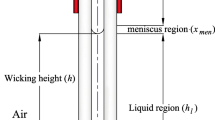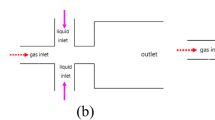Abstract
It is necessary to study the phase transition in capillary cores to achieve more efficient heat transfer. Here, we propose a model to simulate the evaporation of meniscus in microchannel. It is based on the phase field method and kinetic theory for evaporation. The model takes into account the Marangoni effect, the evaporative phase transition process and the change of contact angle. Then the simulation results are compared with the experiments to verify the accuracy of the model. It shows that there is a strong heat flux region near the contact line, which produces the tension gradient along the interface and leads to the Marangoni flow near the meniscus. In addition, results also show that the tube diameter, contact angle and superheat have significant influence on the evaporation rate.













Similar content being viewed by others
Abbreviations
- U :
-
Velocity vector
- P:
-
Pressure
- F g :
-
Gravity
- T:
-
Temperature
- M:
-
Molar mass
- H:
-
The latent heat of vaporization
- k:
-
The heat transfer coefficient
- r:
-
The distance from the interface to the symmetry axis
- G:
-
Chemical potential
- n :
-
Unit vector
- \({\mathbf{F}}_{{\varvec{s}}{\varvec{t}}}\) :
-
Volume force
- t:
-
Time
- m:
-
Mass
- C:
-
Specific heat capacity
- R:
-
Surface energy
- Φ:
-
Phase function
- λ :
-
Mixing energy density
- θ :
-
Contact angle
- χ :
-
Transfer adjustment parameter
- εpf :
-
Capillary width that scales with the thickness of the diffuse interface
- γ :
-
Mobility
- σ :
-
Interfacial tension
- μ :
-
Viscosity coefficient
- ρ :
-
Density
- l :
-
Liquid
- int :
-
Interface
- v :
-
Vapor
- f :
-
Phase field
References
Cai JJ, Li XZ, Tan ZX et al (2021) An assembly-level neutronic calculation method based on LightGBM algorithm. Ann Nucl Energy 150
Hamdan M, Elnajjar E (2009) Thermodynamic analytical model of a loop heat pipe. Heat Mass Transf 46(2):167–173
Li X, Wang J, Hu Q et al (2013) Experimental and theoretical research on capillary limit of micro heat pipe with compound structure of sintered wick on trapezium-grooved substrate. Heat Mass Transf 49(3):381–389
George OA, **ao J, Rodrigo CS et al (2017) Detailed numerical analysis of evaporation of a micrometer water droplet suspended on a glass filament. Chem Eng Sci 165:33–47
Bercovici D, Ricard Y, Schubert G (2001) A two-phase model for compaction and damage: 1. General theory. J Geophys Res 106:8887–8906
Ishii M (1975) Thermo-fluid dynamic theory of two-phase flow. Eyrolles, Paris
Stephan P (1992) Busse C A (1992) Analysis of the heat transfer coefficient of grooved heat pipe evaporator walls. Int J Heat Mass Transf 35:383–391
Schonberg JA, Dasgupta S, Wayner PC (1995) An augmented Young-Laplace model of an evaporating meniscus in a microchannel with high heat flux. Exp Thermal Fluid Sci 10(2):163–170
Kim IY, Ayner PC (2012) Shape of an evaporating completely wetting extended meniscus. J Thermophys Heat Transfer 10(2):320–325
Qu W, Ma T, Miao J et al (2002) Effects of radius and heat transfer on the profile of evaporating thin liquid film and meniscus in capillary tubes. Int J Heat Mass Transf 45(9):1879–1887
Du YS, Zhao YH (2011) Analyses of factors affecting heat transfer in evaporating thin film region. Chem Eng 39(4):54–57
Morris SJS (2003) The evaporating meniscus in a channel. J Fluid Mech 494:297–317
Derjaguin BV (1955) Definition of the concept and magnitude of the disjoining pressure and its role in the statics and kinetics of thin layers of liquids. Colloid J USSR 17:191–197
Sharath P, Rao C, Rahman MM (2006) Numerical simulation of steady state conjugate heat transfer in a circular microtube inside a rectangular substrate. Numer Heat Transf A Appl 49:635–654
Liu X, Hu C, Li H et al (2018) Effects of an Inhomogenous Electric Field on an Evaporating Thin Film in a Microchannel. Int J Thermophys 39(3):43
Chakraborty KPK, S, Dasgupta S, (2011) Experimental investigation of enhanced spreading and cooling from a microgrooved surface. Microfluid Nanofluid 11(4):489
Schmidt GR (1992) Thermocapillary flow about an evaporating meniscus. In: AIAA 27th Thermophysics Conference, Nashville, TN, USA
Wang H, Garimella SV, Murthy JY (2007) Characteristics of an evaporating thin film in a microchannel. Int J Heat Mass Transf 50(19–20):3933–3942
Wang H, Murthy JY, Garimella SV (2008) Transport from a volatile meniscus inside an open microtube. Int J Heat Mass Transf 51(11–12):3007–3017
Li S, Chen R, Zhu X et al (2016) Numerical investigation of the Marangoni convection during the liquid column evaporation in microchannels caused by IR laser heating. Int J Heat Mass Transf 101:970–980
Rice J, Faghri A (2007) Analysis of the Marangoni effect in volatile liquids evaporation from capillary tubes using a new interface tracking method. Numer Heat Transfer A 51:445–468
Dhavaleswarapu HK, Garimella SV, Murthy JY (2009) Microscale temperature measurements near the triple line of an evaporating thin liquid film. J Heat Transfer 131(6):8–14
Yue P, Feng JJ, Liu C et al (2004) A diffuse-interface method for simulating two-phase flows of complex fluids. J Fluid Mech 515:293–317
Wang Y, Cai JJ (2017) Numerical investigation on bubble evolution during nucleate boiling using diffuse interface method. Int J Heat Mass Transf 112:28–38
van der Waals JD (1979) The thermodynamic theory of capillarity under the hypothesis of a continuous variation of density. J Stat Phys 20(2):200–244
Buffone C, Sefiane K (2004) Investigation of thermocapillary convective patterns and their role in the enhancement of evaporation from pores. Int J Multiph Flow 30(9):1071–1091
Chang J (2021) Numerical Simulation and Experimental Study on Heat and Mass Transfer of Microchannel Gas-liqud Two-phase Flow Based on Diffuse Interface Method. South China University of Technology, Guangzhou (In Chinese)
Wayner PC (1994) Thermal effects in the spreading of a liquid film due to a change in the apparent finite contact angle. J Heat Transf 116:938–945
Xu X, Carey VP (2012) Film evaporation from micro-grooved surface: An approximate heat transfer model and its comparison with experimental data. J Thermophys Heat Transf 4(4):512–520
Dhavaleswarapu HK, Garimella SV, Chamarthy P et al (2021) Experimental investigation of steady buoyant-thermocapillary convection near an evaporating meniscus. Phys Fluids. https://doi.org/10.1063/12752477
Funding
This work is supported by the Guangdong Basic and Applied Basic Research Foundation (Grant No. 2020A1515010373, 2021A1515010340).
Author information
Authors and Affiliations
Corresponding author
Additional information
Publisher's Note
Springer Nature remains neutral with regard to jurisdictional claims in published maps and institutional affiliations.
Rights and permissions
About this article
Cite this article
Chang, J., Cai, J. & Tan, B. Numerical simulation of meniscus evaporation in microchannel based on diffuse interface method. Heat Mass Transfer 58, 1949–1962 (2022). https://doi.org/10.1007/s00231-022-03223-0
Received:
Accepted:
Published:
Issue Date:
DOI: https://doi.org/10.1007/s00231-022-03223-0




